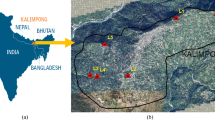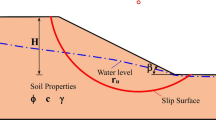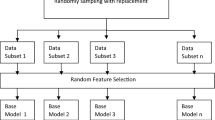Abstract
Significant slope destabilisation may become more likely due to the speed at which urbanisation is occurring, as well as the growing necessity for geoengineering initiatives or the growth of the road network. Slope stability analysis is done to lower the risk of landslides and slope failures. The study area, Kalimpong, is well-known for its lush greenery and stunning views and is situated in the Eastern Himalayas. However, it also constantly confronts the risk of landslides because of its rugged topography, potential seismic zone, and heavy monsoon rains. In this study, the results of the factor of safety computed by limit equilibrium (conventional) method have been compared analytically using computational intelligence and machine learning methodologies for both dry and saturated conditions under dynamic loading. Conventional machine learning techniques are combined with seven prediction models. The following algorithms have been chosen for slope stability analysis: support vector machine, k-nearest neighbours, decision tree, random forest, logistic regression, AdaBoost, and gradient boosting. Random cross-validation is used to assess each model's dependability. The stability condition is the result of the random selection of seven parameters: cohesiveness, unit weight, slope height, angle of the slope, internal friction angle, horizontal and vertical pseudo-static coefficient. Moreover, the coefficient of variation method is employed to assess the importance of every indicator in forecasting slope stability. As per the sensitivity analysis, slope stability is primarily affected by cohesiveness. With an average classification accuracy of 0.878, ensembling approach SVM-Boost demonstrates the best prediction abilities among the models tested using multifold cross-validation. The accuracy ratings of SVM and AdaBoost were 0.865 and 0.834, respectively. When combined with SLOPE/W advances, novel SVM-Boost exhibits the highest exactitude, hegemony, and best outcomes in slope stability prediction. Future earthquakes, strong rainfall, and human activity could cause the slope to collapse. The outcome demonstrates machine learning's enormous potential for enhancing slope stability assessments and provides a means of raising the effectiveness and safety of slope management.

















Similar content being viewed by others
References
Abella EC, Van Westen C (2007) Generation of a landslide risk index map for Cuba using spatial multi-criteria evaluation. Landslides 4(4):311–325. https://doi.org/10.1007/s10346-007-0087-y
Abraham MT, Satyam N, Pradhan B, Alamri AM (2020) IoT-based geotechnical monitoring of unstable slopes for landslide early warning in the Darjeeling Himalayas. Sensors 20(9):2611. https://doi.org/10.3390/s20092611
Agam M, Hashim M, Murad M, Zabidi H (2016) Slope sensitivity analysis using spencer’s method in comparison with general limit equilibrium method. Procedia Chem 19:651–658. https://doi.org/10.1016/j.proche.2016.03.066
Ahangari Nanehkaran Y, Pusatli T, Chengyong J, Chen J, Cemiloglu A, Azarafza M, Derakhshani R (2022) Application of machine learning techniques for the estimation of the safety factor in slope stability analysis. Water 14(22):3743. https://doi.org/10.3390/w14223743
Ai-Jun Y, Yong-Hua S (2003) A method for stability of slope engineering with complicated rock-mass. Chin Civil Eng J 36(11):34–37
Arya P, Patel SB, Bharti G, Shukla BK, Hurukadli P (2023) Impact of using a blend of bagasse ash and polyester fiber in black cotton soil for improvement of mechanical and geotechnical properties of soil. Mater Today Proce 78:738–743
Asteris PG, Rizal FIM, Koopialipoor M, Roussis PC, Ferentinou M, Armaghani DJ, Gordan B (2022) Slope stability classification under seismic conditions using several tree-based intelligent techniques. Appl Sci 12(3):1753. https://doi.org/10.3390/app12031753
Azarafza M, Hajialilue Bonab M, Derakhshani R (2022) A novel empirical classification method for weak rock slope stability analysis. Sci Rep 12(1):14744. https://doi.org/10.1038/s41598-022-19246-w
Azarafza M, Nikoobakht S, Asghari-Kaljahi E, Moshrefy-Far M (2014) Stability analysis of jointed rock slopes using block theory (case study: gas flare site in phase 7 of South Pars Gas Complex). In: Paper presented at the Proceedings of the 32th National & 1st International Geosciences Congress of Iran.
Baker R, Shukha R, Operstein V, Frydman S (2006) Stability charts for pseudo-static slope stability analysis. Soil Dyn Earthq Eng 26(9):813–823. https://doi.org/10.1016/j.soildyn.2006.01.023
Bansal V, Sarkar R (2023) Prophetical modeling using limit equilibrium method and novel machine learning ensemble for slope stability gauging in kalimpong. Iran J Sci Technol Trans Civ Eng. https://doi.org/10.1007/s40996-023-01156-0
Bansal V, Shukla BK (2022) Effects of modifiers on the properties of asphalt for sustainable and improved construction of flexible pavements. J Phys 2267(1):012062
Begum N, Maiti A, Chakravarty D, Das BS (2021) Diffuse reflectance spectroscopy based rapid coal rank estimation: a machine learning enabled framework. Spectrochim Acta Part A Mol Biomol Spectrosc 263:120150
Bhadra D, Dhar N, Salam MA (2022) Sensitivity analysis of the integrated AHP-TOPSIS and CRITIC-TOPSIS method for selection of the natural fiber. Mater Today Proce 56:2618–2629
Bhagat NK, Mishra AK, Singh RK, Sawmliana C, Singh P (2022) Application of logistic regression, CART and random forest techniques in prediction of blast-induced slope failure during reconstruction of railway rock-cut slopes. Eng Fail Anal 137:106230
Bharti JP, Mishra P, Moorthy U, Sathishkumar VE, Cho Y, Samui P (2021) Slope stability analysis using Rf, gbm, cart, bt and xgboost. Geotech Geol Eng 39:3741–3752
Bharti G, Shukla BK, Srinivasan V, Bansal V (2022) Experimental study on eccentrically loaded rectangular footing on sand for embedded condition to enhance serviceability of structures. Mater Today Proc 61:517–522
Bharti G, Hurukadli P, Shukla BK, Sihag P, Jagudi S, Tripathi A (2023a) Environmental impact analysis and utilization of copper slag for stabilising black cotton soil. Materials Today: Proceedings.
Bharti G, Shukla BK, Kumar A, Nagaraju MB, Bansal V, Varadharajan S (2023b) Impact of copper and steel slag blend in strengthening mechanical properties of black cotton soil. In: AIP Conference Proceedings, Vol. 2800, No. 1. AIP Publishing
Biondi G, Cascone E, Maugeri M (2002) Flow and deformation failure of sandy slopes. Soil Dyn Earthq Eng 22(9–12):1103–1114. https://doi.org/10.1016/s0267-7261(02)00136-7
Bird JF, Bommer JJ (2004) Earthquake losses due to ground failure. Eng Geol 75(2):147–179. https://doi.org/10.1016/j.enggeo.2004.05.006
Cevik A (2011) Modeling strength enhancement of FRP confined concrete cylinders using soft computing. Expert Syst Appl 38(5):5662–5673. https://doi.org/10.1016/j.eswa.2010.10.069
Chawla A, Chawla S, Pasupuleti S, Rao A, Sarkar K, Dwivedi R (2018) Landslide susceptibility mapping in Darjeeling Himalayas, India. Adv Civ Eng. https://doi.org/10.1155/2018/6416492
Cheng MY, Hoang ND (2016) Slope collapse prediction using Bayesian framework with k-nearest neighbor density estimation: case study in Taiwan. J Comput Civ Eng 30(1):04014116
Cheng YM, Lansivaara T, Wei W (2007) Two-dimensional slope stability analysis by limit equilibrium and strength reduction methods. Comput Geotech 34(3):137–150. https://doi.org/10.1016/j.compgeo.2006.10.011
Chuhan Z, Pekau O, Feng J, Guanglun W (1997) Application of distinct element method in dynamic analysis of high rock slopes and blocky structures. Soil Dyn Earthq Eng 16(6):385–394. https://doi.org/10.1016/s0267-7261(97)00012-2
Cohen I, Huang Y, Chen J, Benesty J, Benesty J, Chen J, Huang Y, Cohen I (2009) Pearson Correlation Coefficient. In: Noise Reduction in Speech Processing. Springer Topics in Signal Processing, vol 2. Springer, Berlin, Heidelberg. https://doi.org/10.1007/978-3-642-00296-0_5
Cortes C, Vapnik V (1995) Support-vector networks. Mach Learn 20(3):273–297
Das SK (2013) Artificial neural networks in geotechnical engineering: modeling and application issues. Metaheur Water Geotech Transp Eng 45:231–267
Das S, Sarkar S, Kanungo DP (2022) GIS-based landslide susceptibility zonation mapping using the analytic hierarchy process (AHP) method in parts of Kalimpong Region of Darjeeling Himalaya. Environ Monitor Ass 194(4):234. https://doi.org/10.1007/s10661-022-09851-7
Dikshit A, Satyam DN (2018) Estimation of rainfall thresholds for landslide occurrences in Kalimpong, India. Innov Infrastruct Solu 3:1–10. https://doi.org/10.1007/s41062-018-0132-9
Erzin Y, Cetin T (2012) The use of neural networks for the prediction of the critical factor of safety of an artificial slope subjected to earthquake forces. Scientia Iranica 19(2):188–194
Erzin Y, Cetin T (2013) The prediction of the critical factor of safety of homogeneous finite slopes using neural networks and multiple regressions. Comput Geosci 51:305–313
Erzin Y, Nikooy M, Nikooz M, Cetin T (2016) The use of self-organizing feature map networks for the prediction of the critical factor of safety of an artificial slope. Neur Netw World 26(5):461. https://doi.org/10.14311/nnw.2016.26.027
Fattahi H (2017) Prediction of slope stability using adaptive neuro-fuzzy inference system based on clustering methods. J Min Environ 8(2):163–177. https://doi.org/10.2244/jme.2016.637
Feng X, Li S, Yuan C, Zeng P, Sun Y (2018) Prediction of slope stability using naive Bayes classifier. KSCE J Civ Eng 22:941–950
Gordan B, Armaghani DJ, Adnan A, Rashid A (2016a) A new model for determining slope stability based on seismic motion performance. Soil Mech Found Eng 53(5):344–351. https://doi.org/10.1007/s11204-016-9409-1
Gordan B, Jahed Armaghani D, Hajihassani M, Monjezi M (2016b) Prediction of seismic slope stability through combination of particle swarm optimization and neural network. Eng Comput 32:85–97. https://doi.org/10.1007/s00366-015-0400-7
Hoang ND, Bui DT (2017) Slope stability evaluation using radial basis function neural network, least squares support vector machines, and extreme learning machine. In Handbook of neural computation, pp. 333–344, Elsevier
Howland J (1980) Probabilistic seismic stability analysis of earth slopes
Hwang S, Guevarra IF, Yu B (2009) Slope failure prediction using a decision tree: a case of engineered slopes in South Korea. Eng Geol 104(1–2):126–134
Jing-shan B, Guo-dong X, Li-ping J (2001) Seismic response and dynamic stability analysis of soil slopes. Earthq Eng Eng Vib 21(2):116–120
Johari A, Mousavi S, Hooshmand Nejad A (2015) A seismic slope stability probabilistic model based on Bishop’s method using analytical approach. Scientia Iranica 22(3):728–741
Karray M, Hussien MN, Delisle MC, Ledoux C (2018) Framework to assess pseudo-static approach for seismic stability of clayey slopes. Can Geotechn J 55(12):1860–1876
Kayabasi A, Yesiloglu-Gultekin N, Gokceoglu C (2015) Use of non-linear prediction tools to assess rock mass permeability using various discontinuity parameters. Eng Geol 185:1–9
Krishnamoorthy A (2007) Factor of safety of a slope subjected to seismic load. Electronic Journal of Geotechnical Engineering, 12.
Lee S (2004) Application of likelihood ratio and logistic regression models to landslide susceptibility mapping using GIS. Environ Manage 34:223–232
Leroueil S (2001) Natural slopes and cuts: movement and failure mechanisms. Géotechnique 51(3):197–243. https://doi.org/10.1680/geot.2001.51.3.197
Leshchinsky D, San KC (1994) Pseudostatic seismic stability of slopes: design charts. J Geotechn Eng 120(9):1514–1532. https://doi.org/10.1061/(asce)0733-9410(1994)120:9(1514)
Li Y, Yang X (2019) Soil-slope stability considering effect of soil-strength nonlinearity. Int J Geomech 19(3):04018201. https://doi.org/10.1061/(asce)gm.1943-5622.0001355
Lin S, Zheng H, Han C, Han B, Li W (2021) Evaluation and prediction of slope stability using machine learning approaches. Frontiers Struct Civ Eng 15(4):821–833
Lin S, Zheng H, Han B, Li Y, Han C, Li W (2022) Comparative performance of eight ensemble learning approaches for the development of models of slope stability prediction. Acta Geotech 17(4):1477–1502
Liu C, Qi S, Tong L, Zhao FS (2004) Stability analysis of slope under earthquake with FLAC3D. Chin J Rock Mech Eng 23(16):2730–2733
Liu S, Shao L, Li H (2015) Slope stability analysis using the limit equilibrium method and two finite element methods. Comput Geotech 63:291–298. https://doi.org/10.1016/j.compgeo.2014.10.008
Loukidis D, Bandini P, Salgado R (2003) Stability of seismically loaded slopes using limit analysis. Geotechnique 53(5):463–479. https://doi.org/10.1680/geot.2003.53.5.463
Mafi R, Javankhoshdel S, Cami B, Jamshidi Chenari R, Gandomi AH (2021) Surface altering optimisation in slope stability analysis with non-circular failure for random limit equilibrium method. Georisk Ass Manag Risk Eng Syst Geohazards 15(4):260–286. https://doi.org/10.1080/17499518.2020.1771739
Manouchehrian A, Gholamnejad J, Sharifzadeh M (2014) Development of a model for analysis of slope stability for circular mode failure using genetic algorithm. Environ Earth Sci 71:1267–1277. https://doi.org/10.1007/s12665-013-2531-8
Mao Y, Chen L, Nanehkaran YA, Azarafza M, Derakhshani R (2023) Fuzzy-based intelligent model for rapid rock slope stability analysis using qslope. Water 15(16):2949
Mathe L, Ferentinou M (2021) Rock slope stability analysis adopting Eurocode 7, a limit state design approach for an open pit. In: Paper presented at the IOP Conference Series: Earth and Environmental Science.
Melo C, Sharma S (2004) Seismic coefficients for pseudostatic slope analysis. In: Paper presented at the 13th World conference on earthquake engineering.
Mohamed T, Kasa A (2014) Application of fuzzy set theory to evaluate the stability of slopes. In: Paper presented at the Applied Mechanics and Materials.
Morgenstern NU, Price VE (1965) The analysis of the stability of general slip surfaces. Geotechnique 15(1):79–93. https://doi.org/10.1680/geot.1965.15.1.79
Mukherjee A, Mitra A (2001) Geotechnical study of mass movements along the Kalimpong approach road in the Eastern Himalayas. Indian J Geol 73(4):271–280
Nanehkaran YA, Chen B, Cemiloglu A, Chen J, Anwar S, Azarafza M, Derakhshani R (2023a) Riverside landslide susceptibility overview: leveraging artificial neural networks and machine learning in accordance with the United Nations (UN) sustainable development goals. Water 15(15):2707
Nanehkaran YA, Licai Z, Chengyong J, Chen J, Anwar S, Azarafza M, Derakhshani R (2023b) Comparative analysis for slope stability by using machine learning methods. Appl Sci 13(3):1555
Newmark NM (1965) Effects of earthquakes on dams and embankments. Geotechnique 15(2):139–160. https://doi.org/10.1680/geot.1965.15.2.139
Nouri H, Fakher A, Jones C (2008) Evaluating the effects of the magnitude and amplification of pseudo-static acceleration on reinforced soil slopes and walls using the limit equilibrium horizontal slices method. Geotext Geomembr 26(3):263–278. https://doi.org/10.1016/j.geotexmem.2007.09.002
Pradhan SP, Siddique T (2020) Stability assessment of landslide-prone road cut rock slopes in Himalayan terrain: a finite element method based approach. J Rock Mechan Geotechn Eng 12(1):59–73. https://doi.org/10.1016/j.jrmge.2018.12.018
Qi C, Tang X (2018) Slope stability prediction using integrated metaheuristic and machine learning approaches: a comparative study. Comput Ind Eng 118:112–122
Roy P, Ghosal K, Paul PK (2022) Landslide susceptibility mapping of kalimpong in Eastern Himalayan region using a Rprop ANN approach. J Earth Syst Sci 131(2):130. https://doi.org/10.1007/s12040-022-01877-2
Saha S, Sarkar R, Roy J, Hembram TK, Acharya S, Thapa G, Drukpa D (2021) Measuring landslide vulnerability status of Chukha, Bhutan using deep learning algorithms. Sci Rep 11(1):16374
Sakellariou M, Ferentinou M (2005) A study of slope stability prediction using neural networks. Geotech Geol Eng 23:419–445. https://doi.org/10.1007/s10706-004-8680-5
Samui P (2008) Slope stability analysis: a support vector machine approach. Environ Geol 56:255–267
Sarkar R, Dorji K (2019) Determination of the probabilities of landslide events—a case study of Bhutan. Hydrology 6(2):52
Seed HB (1979) Considerations in the earthquake-resistant design of earth and rockfill dams. Geotechnique 29(3):215–263. https://doi.org/10.1680/geot.1979.29.3.215
Shrestha S, Kang TS (2019) Assessment of seismically-induced landslide susceptibility after the 2015 Gorkha earthquake. Nepal Bull Eng Geol Environ 78:1829–1842. https://doi.org/10.1007/s10064-017-1191-4
Siad L (2003) Seismic stability analysis of fractured rock slopes by yield design theory. Soil Dyn Earthq Eng 23(3):21–30. https://doi.org/10.1016/s0267-7261(02)00213-0
Singh A, Halgamuge MN, Lakshmiganthan R (2017) Impact of different data types on classifier performance of random forest, naive bayes, and k-nearest neighbors algorithms. International Journal of Advanced Computer Science and Applications, 8(12)
Siyahi BG, Bilge G (1998) A pseudo-static stability analysis in normally consolidated soil slopes subjected to earthquake. Teknik Dergi/techn J Turkish Chamber Civ Eng 9:457–461
Sousa R, Karam KS, Costa AL, Einstein HH (2017) Exploration and decision-making in geotechnical engineering–a case study. Georisk Ass Manag Risk Eng Syst Geohazards 11(1):129–145
Suman S, Khan S, Das S, Chand S (2016) Slope stability analysis using artificial intelligence techniques. Nat Hazards 84:727–748. https://doi.org/10.1007/s11069-016-2454-2
Tang C, Zhu J, Qi X, Ding J (2011) Landslides induced by the Wenchuan earthquake and the subsequent strong rainfall event: a case study in the Beichuan area of China. Eng Geol 122(1–2):22–33. https://doi.org/10.1016/J.ENGGEO.2011.03.013
Tripathi A, Langhi M, Shukla BK, Kumar A, Bharti G (2023) Assessment of sedimentation rate in Sipu reservoir using remote sensing & GIS technique. In: AIP Conference Proceedings, Vol. 2800, No. 1. AIP Publishing
Wang Y, Cao Z, Au SK (2011) Practical reliability analysis of slope stability by advanced Monte Carlo simulations in a spreadsheet. Can Geotech J 48(1):162–172. https://doi.org/10.1139/t10-044
Wasowski J, Keefer DK, Lee CT (2011) Toward the next generation of research on earthquake-induced landslides: current issues and future challenges. Eng Geol 122(1–2):1–8. https://doi.org/10.1016/j.enggeo.2011.06.001
Xie H, Dong J, Deng Y, Dai Y (2022) Prediction model of the slope angle of rocky slope stability based on random forest algorithm. Math Probl Eng 2022:1–10
Yue Z, Kang X (2021) Different contributions of two shear strength parameters to soil slope stability with limit equilibrium method based slice techniques. In: Paper presented at the IOP Conference Series: Earth and Environmental Science.
Zhu D, Lee C, Jiang H (2003a) Generalised framework of limit equilibrium methods for slope stability analysis. Geotechnique 53(4):377–395. https://doi.org/10.1680/geot.53.4.377.37322
Zhu D, Lee C, Jiang H (2003b) Generalised framework of limit equilibrium methods for slope stability analysis. Geotechnique 53(4):377–395
Zhu D, Lee C, Qian Q, Chen G (2005) A concise algorithm for computing the factor of safety using the Morgenstern Price method. Can Geotech J 42(1):272–278. https://doi.org/10.1139/t04-072
Zhu D (2008) Investigations on the accuracy of the simplified Bishop method. In: Landslides and Engineered Slopes. From the Past to the Future, Two Volumes+ CD-ROM (pp. 1077–1080): CRC Press.
Author information
Authors and Affiliations
Corresponding author
Ethics declarations
Conflict of interest
This document has not been submitted for any other reason.
Rights and permissions
Springer Nature or its licensor (e.g. a society or other partner) holds exclusive rights to this article under a publishing agreement with the author(s) or other rightsholder(s); author self-archiving of the accepted manuscript version of this article is solely governed by the terms of such publishing agreement and applicable law.
About this article
Cite this article
Bansal, V., Sarkar, R. Comparative Analysis of Slope Stability for Kalimpong Region under Dynamic Loading Using Limit Equilibrium Method and Machine Benchmark Learning Classifiers. Iran J Sci Technol Trans Civ Eng (2024). https://doi.org/10.1007/s40996-024-01344-6
Received:
Accepted:
Published:
DOI: https://doi.org/10.1007/s40996-024-01344-6




